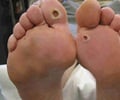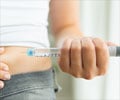
The biochip developed by engineers at Brown University uses plasmonic interferometers and could be used to measure a range of biological and environmental substances.
The technique takes advantage of a convergence of nanotechnology and surface plasmonics, which explores the interaction of electrons and photons (light).
The engineers at Brown etched thousands of plasmonic interferometers onto a fingernail-size biochip and measured the concentration of glucose molecules in water on the chip.
Their results showed that the specially designed biochip could detect glucose levels similar to the levels found in human saliva. Glucose in human saliva is typically about 100 times less concentrated than in the blood.
"This is proof of concept that plasmonic interferometers can be used to detect molecules in low concentrations, using a footprint that is ten times smaller than a human hair," said Domenico Pacifici, assistant professor of engineering and lead author of the study.
Advertisement
"It could be possible to use these biochips to carry out the screening of multiple biomarkers for individual patients, all at once and in parallel, with unprecedented sensitivity," Pacifici noted.
Advertisement
"The proposed approach will enable very high throughput detection of environmentally and biologically relevant analytes in an extremely compact design. We can do it with a sensitivity that rivals modern technologies," Pacifici added.
The results are published in published in Nano Letters, a journal of the American Chemical Society.
Source-ANI










